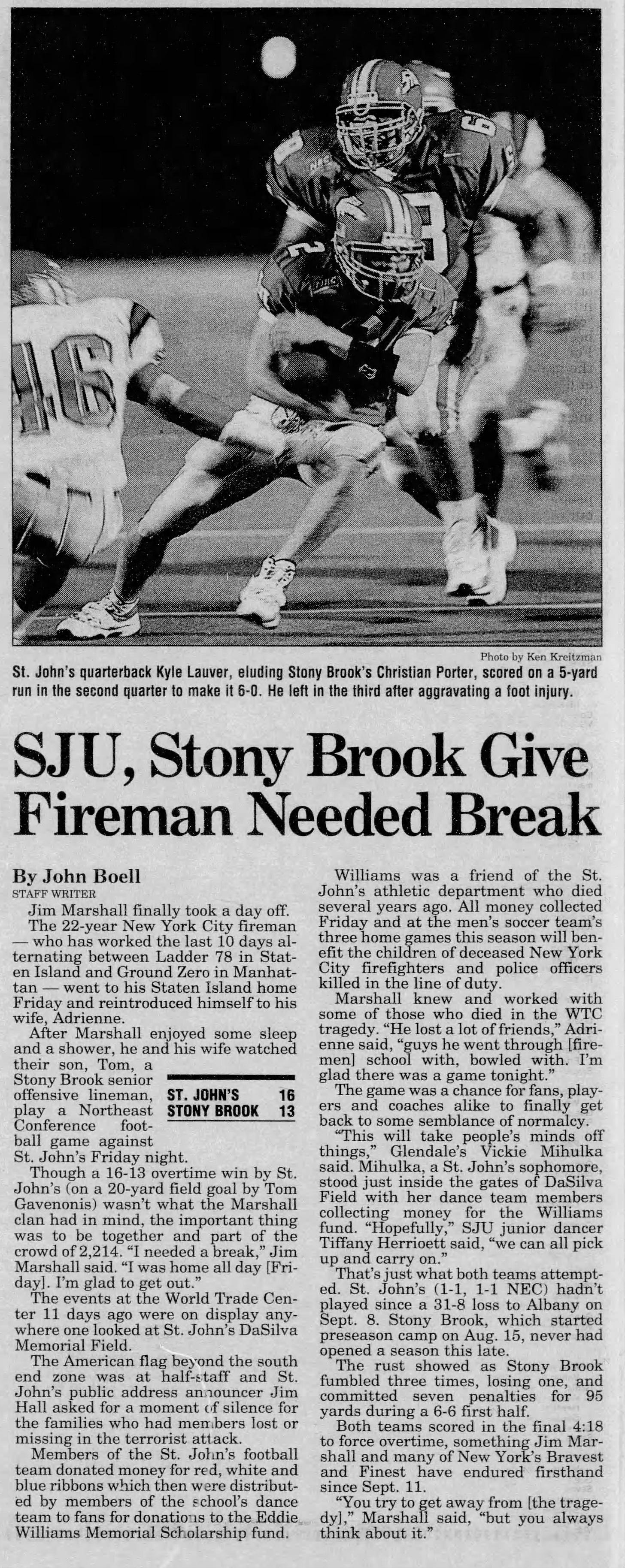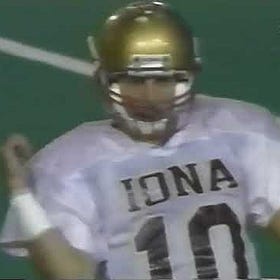New York's Overlooked Post-9/11 Games
While the nation watched New York regain some normalcy through baseball, a city devastated by the 9/11 terrorist attacks welcomed college football back with a full slate of games in Sept. 2001.
Plenty of the immediate reaction to the Sept. 11 terrorist attacks proved negative, whether on a micro or macro scale. With nearly a quarter-century of hindsight now, though, the response that came from sports remains as uplifting today as it was in the aftermath of that tragic Tuesday in 2001.
Baseball in particular carried the flag for our nation in the weeks following 9/11 — and in the case of Sammy Sosa, that’s flag-carrying in a literal sense.
The home stretch of the 2001 season and ensuing postseason, which delivered what I consider the best Playoffs of my lifetime, marked the last time baseball truly was America’s Pastime. I write that not as a critique of the sport; it’s a simple fact that football, which had already bypassed baseball as the nation’s most popular game, exploded in its prominence during the 2000s.
However, moments like Sosa’s flag-waving home run, Barry Bonds mashing 10 out of the park in 17 days, the epic Yankees-Athletics ALDS and what was the best World Series of the last 40 years encapsulated why baseball was so firmly woven into American culture for so long.
Sports returned to New York on Sept. 21, 10 days after the 9/11 attacks. The Mets beat the Atlanta Braves at Shea Stadium, 3-2, when Mike Piazza hit a two-run homer in the eighth inning. Then-Mayor Rudy Giuliani was in attendance for a game that attracted national attention.
Commanding far less spotlight that same Friday night, not far from Shea Stadium, the St. John’s Red Storm football team outlasted Stony Brook, 16-13.
The win improved St. John’s to 1-1, with the Red Storm having lost their opener at UAlbany three days before 9/11, 31-6.
St. John’s didn’t win again for the rest of the 2001 season. But the Red Storm’s lone victory came at an opportune time, and came with particular meaning as the Newsday recap details.
There may be some readers asking themselves, St. John’s had a football team? Indeed it did, though the Red Storm did not last long into the 21st Century. The 2001 campaign was the program’s penultimate. After an effort to make it work in the Northeast Conference, St. John’s returned to the Metro Atlantic Athletic Conference in 2002 before closing up shop altogether.
The MAAC ceased football operations in its own right shortly thereafter, and many of the conference’s members shuttered their gridiron programs.
Saint Peter's and the Short Existence of MAAC Football
Before its basketball program’s improbable run to this season’s Elite Eight, Saint Peter’s athletics barely registered a blip on the proverbial radar. Case in point: The closure of Peacocks football less than three months before kickoff of the 2007 season garnered only a brief in the
America’s three most populous metropolitan areas are surprisingly barren when it comes to college football. Los Angeles has its two power-conference programs, including one of the game’s most prominent members in USC. But the Southland and its neighboring communities once had a thriving football landscape that has gone mostly dormant.
The Chicagoland has Northwestern. Up until just this year with Roosevelt University moving from NAIA to Div. II, however, NU was the city’s sole NCAA scholarship program. Including Northern Illinois, located about 70 miles west in DeKalb, is a real stretch.
Most sparsely populated of all, though, is America’s most populated city.
New York was, at one time, the epicenter of college football. Burgeoning powerhouses of the late 19th Century played their Thanksgiving Day games at the Polo Grounds, attracting tens of thousands to contests with national championship implications.
As the cultural epicenter of the nation (world?) then, too, New York-based newspapers and periodicals spread college football fever to the rest of America. As college football grew in popularity elsewhere, its significance in New York faded throughout the 20th Century.
Not counting Rutgers, metropolitan New York has no power program. The Five Boroughs, Long Island, and the northern New Jersey suburbs combine for the most Div. I programs of the nation’s three largest cities, but even that group has been significantly scaled back in the two decades since 9/11.
Still, I think back to autumn 2001 and recall the role college football played in providing some small comfort to the country. I didn’t watch the Sept. 20 game between Mississippi State and South Carolina live, but I have revisited it many times in the years since thanks to YouTube.
I was a college freshman at this time, having left home for the first time in my life just a few weeks earlier. The first sizable gathering I attended after 9/11 was Arizona’s Sept. 22 matchup with UNLV.
Like much of the world at this time, I felt uneasy and unsure of how to process my fear, uncertainty and anger. But I still knew I loved watching sports, so a few hours of not particularly well-played football was a welcomed respite.
Being a teenager at the time was especially unnerving. That previous spring while preparing for the next stage in my life, I seriously entertained joining the Army Reserves to both help pay for college, and have an additional path for my prospective journalism career. The recruiter with whom I spoke for several weeks gave me extensive material and background on the Army’s media opportunities, including reporting for Stars and Stripes. He pitched me the idea of covering the Army-Navy Game at some point in my life.
And I was indeed tuned into the Army-Navy Game roughly six months later, watching with a heavy realization that haunted me throughout the fall of 2001; the realization that so many of the people involved would almost inevitably be at war.
Regardless how one feels about his politics and his decision-making preceding then following the 9/11 attacks, then-Pres. George W. Bush’s involvement in high-profile sporting events offered moments of national unity. His first pitch at Yankee Stadium before Game 3 of the World Series is iconic.
The 2001 Army-Navy Game was arguably the most significant in terms of the underlining reality of each academy since the 1941 edition. I highly recommend Lars Anderson’s terrific “The All-Americans” that covers the ‘41 Army-Navy Game.
A key difference, however, was that Army and Navy played on Nov. 29, 1941 — a little more than a week before the Japanese attack on Pearl Harbor. The Cadets and Midshipmen involved in that game weren’t yet in a transformed world the way that their successors 60 years later were come December.
There is an excellent 2011 documentary on the 2001 Game, From Philadelphia to Fallujah, that captures the magnitude of this moment with the added benefit of hindsight.
The documentary captures the sacrifice that one makes when enlisting. Those of my age who weren’t enlisted, meanwhile, faced uncertainty. Would the invasion of Afghanistan require reinstitution of the draft? And what if this is the catalyst to a new World War?
These were questions lingering over my peers, along with other shadows of doubt. I was on the other side of the country in Arizona, but we followed as tangential connections slowly trickled into the public. Some 9/11 hijackers spent time in San Diego; that’s a straight shot west from Tucson on the 8 and a popular vacation destination for Arizonans. More hijackers still trained at Embry-Riddle Aeronautical University — and while they were at the school’s Florida campus, ERAU has a campus in my sleepy hometown of Prescott.
We were fearful from connections that took a major leap to make. I cannot imagine how much more shocked, grief-stricken and terrified those of my age were who lived in the shadows the World Trade Center once cast.
With this thought in mind, I became interested in the college football games played in and around New York City immediately following 9/11. They lacked the pomp and circumstance of coinciding events, like the Mets’ win over the Braves or the Yankees’ World Series run, but they are equally significant.
In some ways, they are more significant. These were games played by young men who were the age of military later sent to fight in Afghanistan and Iraq. These games involved the youngest generation of adults entering a world that was fundmentally changed from that which their parents experienced.
The first weekend of college football after 9/11 featured:
St. John’s defeating Stony Brook, 16-13, in Jamaica Queens
Wagner losing 35-30 vs. Georgetown in Staten Island
A Hofstra team that spent eight weeks ranked in the Div. I-AA top 10 outpacing Maine, 51-44, on Long Island
Saint Peter’s, located just across the Hudson River from New York in Jersey City and at the closest venue to where the World Trade Center stood, avenging its sole loss of the season with a 27-7 defeat of Saint Francis (Pennsylvania)
Columbia dropping a 23-20, overtime thriller with Bucknell at Wien Stadium in Manhattan
Each of these games, these teams and their members, and each of their experiences deserve a much more thorough examination. I aim to one day soon provide it. In the meantime, the small part they played in sports providing some joy and some normalcy amid tragedy and uncertainty should be remembered alongside the triumphant images of baseball offering our nation a uniting force.






